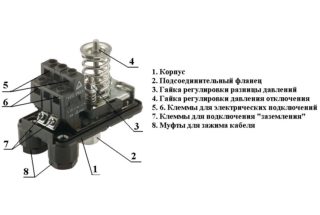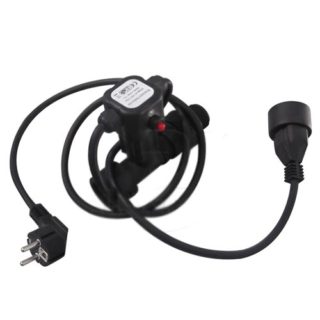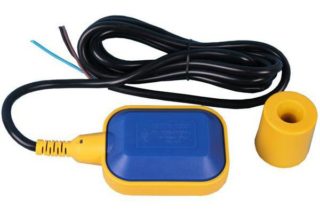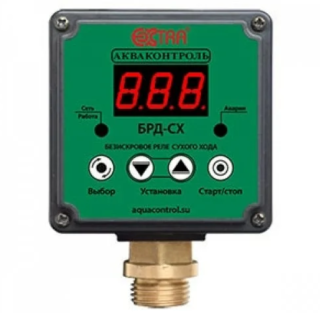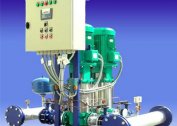The design of the water pump is designed in such a way that the water pumped by it is used inside the device as a coolant and lubricant for rotating parts and assemblies. Therefore, if the pump unit operates without water, its service life will sharply begin to decrease due to the abrasion of these parts and assemblies. The situation can be resolved today without any problems. There are several options - connecting the dry running relay to the pumping station, installing a sensor, float switch or pressure switch.
Dry running relay
A relay is an electromechanical device of the simplest type, inside of which a sensitive membrane is installed. It responds to pressure inside the water supply network. The dry running device itself is installed after the pump, connecting both together with a pipe fitting.
The principle of operation of the relay is that the membrane bends under water pressure. She presses on a pair of contacts that rise and cling to another pair. There is a short circuit of the electrical circuit from which the pump is powered. The relay in this case acts as a conventional switch.
As soon as the pressure inside the water supply starts to drop and reaches a certain level, the membrane returns to its original position. The contacts open, that is, the power supply to the pump installation is turned off. The latter stops working. A pressure drop can occur in two cases:
- lack of water in the tank (well, well) from which water is taken;
- insufficient amount of fluid;
- clogged filters;
- incorrect location (high) of the suction part of the pipe or hose.
If the dry run relay is not installed on the pump, the water pumping unit will quickly fail. The reason is the strong heating of rotating parts, plus the lack of lubrication, which will lead to sticking of metal nodes to each other or their fracture. This is especially true for bearings, which are the bearings of a rotating shaft. The impeller is installed on the latter - the working body that is responsible for pumping water.
There is one nuance that relates to the installation of the relay, depending on the type of pump used. For example, after pumping stations, this dry-running protection device cannot be mounted, since the accumulator, which is an integral part of the station, constantly maintains the pressure inside the water supply network located after the device.
If a relay is installed after the NS, it will always be under pressure. Regardless of whether there is water in the supply tank or not, the pump motor will always work, because the membrane in the relay is in a bent state. Contacts are always pressed against each other. The pump does not turn off, even if it does not pump enough water.
The process may not last long, but even this time is enough to reduce the operational life of the pumping station. In this situation, the liquid flow sensor can solve the problem of dry running.
Dry run sensor
The device is presented on the market in two versions: electromechanical and electronic. The latter are called controllers.
Electromechanical
In this category there are two designs: flap and turbine. The former are somewhat reminiscent of a membrane relay, only instead of a membrane a metal plate is installed here. In the presence of water pressure inside the water supply, it bends and closes the contacts of the motor power supply.As soon as the pressure drops below a certain level or disappears altogether, the plate straightens, breaking the electrical contacts, that is, it stops the pump.
The turbine model of the dry-running sensor is named so because a small turbine is located inside the device. It rotates under the action of moving water, creating an electromagnetic field, because the turbine rotor is an electromagnet. The field created by rotation sends electrical impulses, which are detected by a specially installed sensor. Depending on how many pulses per unit time the sensor receives, the system decides to turn the pump on or off.
Electronic
This type of sensors performs two functions at once: it works as a pressure switch and protects the pump from dry running, that is, it replaces the fluid flow switch. They do not have a mechanical part, so these devices work much more accurately and longer. But their price is higher than everyone else.
It is recommended that electronic devices be installed in water supply networks in which pumps with a small pressure head are installed. If the pressure head is large, it is better to use a separate pressure sensor, which is installed after the pumping equipment.
Float switch
The dry running protection element for pumps is only installed in well or submersible models. At pumping stations and surface units, the float is not mounted; here it is useless.
The principle of operation of the device is that at a high water level in the well, the float is in the upper position, closing the electrical contacts through the lever. As soon as the water level begins to fall, the float lowers, opening the contacts of the trigger.
Electronic relays
The electronic version of the dry-running protection relays for pumps is a new approach to solving the problem. Its main feature is contacts that sink into the water. At the same time, the device itself is located separately from the water supply network and pump.
Contacts can be lowered into a well or a well. Then they work on the principle of determining the water level, so they are lowered below the intake part of the pump unit. It can be embedded in a water pipe. In this case, the device will operate on the principle of a pressure sensor or a fluid flow switch.
The principle of operation of electronic relays is based on the use of water as a transmitter of electrical pulses. As long as there is water between the electrodes that passes current through itself, the electric circuit is in a closed position. As soon as the water level drops, the electrodes are exposed, the circuit is opened - the pump motor remains without power.
Devices on the market make it possible to increase the time of trouble-free operation of pumping units. The purpose of dry-running sensors for the pump station or individual pumps is one thing - to prevent the unit from overheating. Sometimes a single installed relay is not enough to ensure the safe operation of the entire system, so it is necessary to more carefully approach the design of an autonomous water supply taking into account the parameters of the supplied water. In addition to the relay or sensor, it is recommended to install a check valve, a hydraulic accumulator and other protective devices.
